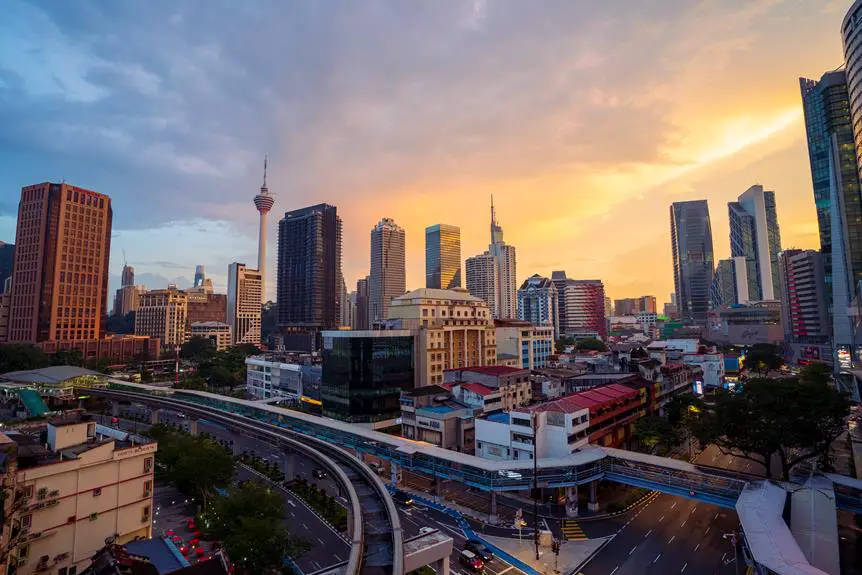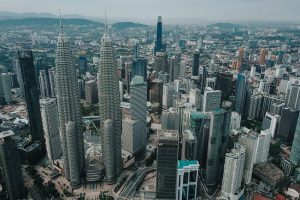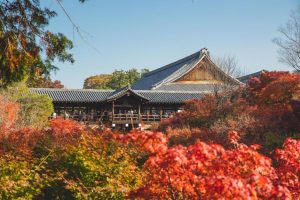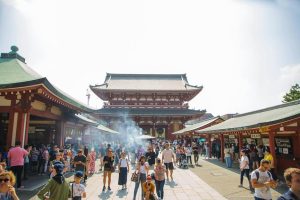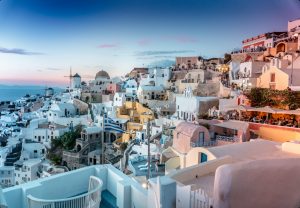Kuala Lumpur, the vibrant capital city of Malaysia, stands as a testament to the nation's rich cultural diversity. With its historical roots deeply intertwined with the influences of various ethnic groups, Kuala Lumpur has emerged as a multicultural hub that celebrates the harmonious coexistence of different traditions, languages, and religions.
From exploring the charming ethnic neighborhoods to experiencing the kaleidoscope of cultures through festivals and celebrations, there is much to discover in this cosmopolitan city.
Moreover, Kuala Lumpur's iconic landmarks and culinary delights offer a glimpse into the fusion of flavors and architectural marvels that make it a truly unique destination.
As we delve into the intricacies of Kuala Lumpur's multiculturalism, prepare to be captivated by the tapestry of experiences that await.
Historical Roots of Cultural Diversity
Kuala Lumpur, Malaysia's multicultural hub, owes its rich tapestry of cultural diversity to a complex history that spans centuries. The city's cultural roots can be traced back to the colonial influences and indigenous traditions that have shaped its identity.
During the colonial era, Kuala Lumpur came under the influence of various European powers, including the Portuguese, Dutch, and British. These colonial powers brought with them their own cultural practices, customs, and architectural styles, which left a lasting impact on the city. The British, in particular, played a significant role in shaping Kuala Lumpur's urban landscape, introducing elements such as Victorian-era buildings and a system of governance that still exists today.
However, amidst these colonial influences, indigenous traditions have managed to endure and thrive. The city is home to various ethnic groups, including Malays, Chinese, Indians, and indigenous communities such as the Orang Asli. Each group has contributed to Kuala Lumpur's cultural diversity, bringing with them their unique traditions, languages, and cuisines.
Today, Kuala Lumpur stands as a melting pot of cultures, where colonial influences and indigenous traditions coexist harmoniously. The city's vibrant festivals, culinary delights, and architectural marvels reflect this diverse heritage, offering visitors a glimpse into the historical roots of its cultural diversity.
Exploring Kuala Lumpur's Ethnic Neighborhoods
Embark on a captivating journey through the vibrant streets of Kuala Lumpur, where the city's ethnic neighborhoods showcase a plethora of cultural treasures waiting to be explored. Each neighborhood is a microcosm of Malaysia's rich heritage and offers a unique experience to visitors.
Chinatown, located in the heart of the city, is a bustling hub filled with traditional crafts and bustling markets. Here, you can immerse yourself in the sights, sounds, and smells of Chinese culture. Explore the vibrant Petaling Street, known for its bustling market stalls selling everything from traditional Chinese herbs to imitation designer goods. Don't forget to sample some delicious street food, such as Hokkien mee or char kuey teow.
Just a short distance away lies Little India, where the vibrant colors and intoxicating scents will transport you to the Indian subcontinent. Visit the Sri Kandaswamy Kovil, a majestic Hindu temple, or browse through the shops selling traditional textiles and jewelry. Don't miss the opportunity to savor the flavors of Indian cuisine, from spicy curries to aromatic biryanis.
For a taste of Malay culture, head to Kampung Baru, a traditional Malay village nestled amidst the modern skyscrapers. Engage with the local community and learn about their way of life. You can witness the art of batik-making or try your hand at traditional Malay crafts. Indulge in the delectable local delicacies like nasi lemak or satay.
These ethnic neighborhoods not only provide an opportunity to explore different cultural facets but also offer avenues for community engagement. Whether it's through learning traditional crafts or sampling authentic cuisines, these neighborhoods create a space for cultural exchange and celebration.
Iconic Landmarks Showcasing Malaysia's Multiculturalism
Malaysia's multiculturalism is beautifully showcased through its iconic landmarks that serve as a testament to the diverse cultural heritage of Kuala Lumpur. The city is home to a plethora of architectural marvels that celebrate the different cultures and religions that coexist harmoniously within its borders.
One such landmark is the Sultan Abdul Samad Building, a stunning example of cultural architecture that blends Moorish, Indian, and Islamic influences. Its intricate details and grandeur make it a symbol of Malaysia's rich history and multicultural identity.
Another iconic landmark is the Thean Hou Temple, a majestic Chinese temple that stands proud on a hilltop. This religious architecture marvel features a blend of Buddhist, Taoist, and Confucian elements, showcasing the Chinese community's devotion to their faith.
The Masjid Jamek, or Jamek Mosque, is another significant landmark that highlights Malaysia's multiculturalism. This mosque is a beautiful fusion of Indian, Moorish, and Islamic architectural styles, reflecting the diverse Muslim population in Kuala Lumpur.
The Batu Caves, with its towering limestone cliffs and vibrant Hindu shrines, is a popular tourist destination that showcases the cultural and religious diversity of the Indian community. The colorful statues and intricate carvings make it a visually stunning representation of Malaysia's multiculturalism.
These iconic landmarks not only attract visitors from around the world but also serve as a reminder of Malaysia's commitment to celebrating and preserving its diverse cultural heritage.
Festivals and Celebrations: A Kaleidoscope of Cultures
A vibrant tapestry of cultural festivities and joyous celebrations illuminates the streets of Kuala Lumpur, showcasing the diverse heritage and traditions of its multicultural population. Kuala Lumpur is a city that thrives on its festivals and celebrations, which serve as a platform for different communities to come together and share their customs and beliefs.
One of the most anticipated events is the Thaipusam festival, where devotees pierce their bodies with hooks and skewers as an act of penance and gratitude. The procession, accompanied by traditional music and dance performances, creates an electrifying atmosphere that is both awe-inspiring and captivating.
Another significant festival is Chinese New Year, where the city is adorned with vibrant red lanterns and traditional Chinese decorations. The streets come alive with lion and dragon dances, symbolizing good luck and prosperity for the upcoming year. The festivities continue with cultural performances and martial arts demonstrations, showcasing the rich Chinese heritage.
The Hari Raya Aidilfitri celebration is a time of joy and forgiveness for Muslims in Kuala Lumpur. The city is adorned with colorful lights, and Muslims don their finest traditional costumes, known as baju kurung and baju Melayu, as they gather with family and friends to break their fast and exchange gifts.
Culinary Delights: a Fusion of Flavors From Around the World
The vibrant tapestry of cultural festivities and celebrations in Kuala Lumpur extends beyond the realm of traditions and customs, enticing visitors and locals alike with a culinary journey that is a fusion of flavors from around the world.
Kuala Lumpur is a melting pot of cultures, and this diversity is reflected in its vibrant food scene. The city offers a plethora of dining options, ranging from street food stalls to upscale restaurants, each offering a unique gastronomic experience.
Food fusion is a prominent feature of Kuala Lumpur's culinary landscape. The city's diverse population has led to a blending of flavors and cuisines, resulting in a truly unique culinary exploration. In Kuala Lumpur, one can savor Indian curries, Chinese stir-fries, Malay satay, and Middle Eastern kebabs, all in the same neighborhood.
For those seeking a truly immersive culinary experience, a visit to the bustling night markets is a must. Here, you can sample a wide array of local delicacies, such as nasi lemak (coconut rice with sambal), roti canai (flaky bread with curry), and char kway teow (stir-fried noodles). These markets not only offer delicious food but also provide a glimpse into the vibrant local culture.
Kuala Lumpur's culinary scene is a testament to the city's multiculturalism. It is a place where food becomes a bridge between different cultures, bringing people together and creating a shared experience. So, whether you are a food enthusiast or simply looking to embark on a culinary adventure, Kuala Lumpur is sure to satisfy your taste buds and leave you craving for more.
Frequently Asked Questions
What Is the Weather Like in Kuala Lumpur?
The weather in Kuala Lumpur is known for its tropical climate, characterized by high humidity and temperatures ranging from 25 to 35 degrees Celsius. The city offers a variety of transportation options, including buses, trains, and taxis.
How Can I Get Around the City Using Public Transportation?
Navigating Kuala Lumpur is made easy with a range of public transportation options. From the efficient light rail system to the extensive bus network, commuters can easily explore the city. Fare rates and passes are available for convenient travel.
Are There Any Famous Shopping Districts in Kuala Lumpur?
Kuala Lumpur boasts several famous shopping districts, making it a paradise for shopaholics. The city is home to top shopping malls such as Suria KLCC, Pavilion Kuala Lumpur, and Mid Valley Megamall, offering a wide range of luxury brands and trendy shops.
What Are Some Popular Outdoor Activities or Attractions in the City?
Popular outdoor activities in Kuala Lumpur include exploring the numerous hiking trails in the surrounding areas, such as Bukit Tabur and Bukit Nanas. The city also hosts various cultural festivals throughout the year, offering a vibrant and immersive experience for visitors.
Are There Any Specific Customs or Etiquette That Visitors Should Be Aware of When Interacting With Locals in Kuala Lumpur?
When visiting Kuala Lumpur, it is important to be aware of the cultural norms and greeting customs. Locals appreciate respectful behavior, such as removing shoes before entering homes and using the right hand for greetings and eating.
Conclusion
In conclusion, Kuala Lumpur stands as a vibrant multicultural hub, showcasing Malaysia's rich diversity. From its historical roots to its ethnic neighborhoods, the city provides a fascinating exploration of different cultures.
Iconic landmarks highlight the country's multiculturalism, while festivals and celebrations offer a kaleidoscope of traditions. And not to forget the culinary delights, where a fusion of flavors from around the world can be savored.
Kuala Lumpur truly exemplifies the harmonious coexistence of various cultures in one thriving metropolis.

